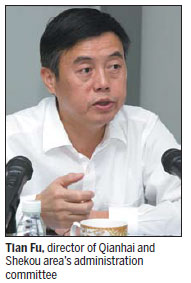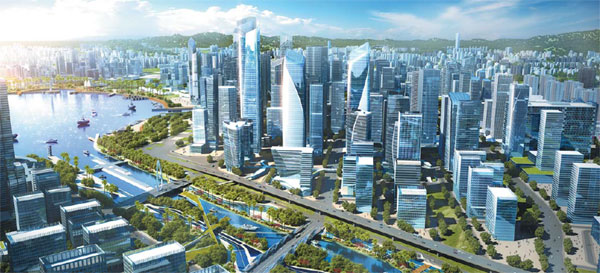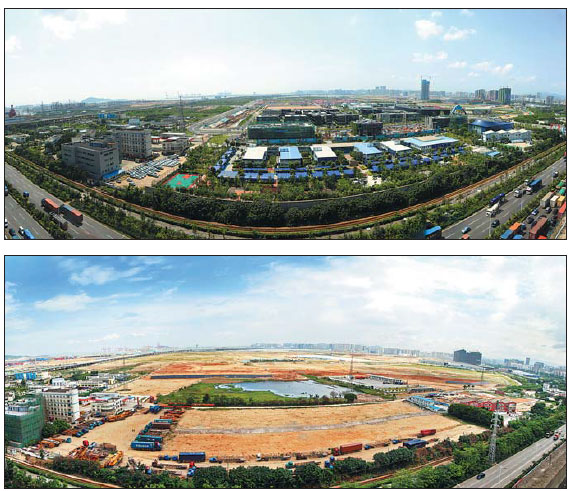All going to plan in FTZ's newest area
Policies in place, infrastructure being built for addition to Guangdong free trade zone
The Qianhai and Shekou area of China (Guangdong) Pilot Free Trade Zone will be built along with the opening-up of China's financial sector, and into an important service, trade and port base, said Tian Fu, director of the area's administration committee.
The area, which covers 28.2 square kilometers, was officially established on April 27. Located in Shenzhen, China's first special economic zone and one of China's most developed cities with strong economic growth, the Qianhai and Shekou area is designed to explore the further internationalization of the renminbi and financial cooperation with the Hong Kong and Macao special administrative regions.
In October, Hu Chunhua, Guangdong Party chief, urged Qianhai and Shekou in Shenzhen, Nansha in Guangzhou and Hengqin in Zhuhai, which together form the Guangdong free trade zone, to stick to high standards and high requirements in their planning and construction, and jointly help the Guangdong FTZ stand out among the four national-level free trade zones. The other three are in Shanghai, Tianjin and Fujian.
The construction of the Qianhai and Shekou area sped up in August. Investment in the 10 key construction projects in the zone, which include office buildings, roads and production and logistics bases, totaled 10.92 billion yuan ($1.7 billion) from August to October, accounting for 53 percent of the investment from January to October.
The administration committee of Qianhai and Shekou area has modified its negative list for the entry of foreign trade and investment, Tian said in a meeting in November. The committee, through coordination with relevant government departments n, has formed a reform plan on FTZ policies and rules that proposes 80 reforms of the current institutional framework.
The committee, with the support of the People's Bank of China's branch in Shenzhen, has worked with financial authorities and banks to draft a package of promotional policies to stimulate the modern service sector cooperation among Shenzhen, Hong Kong and Macao, and the opening-up of the financial sector in the zone, said Tian.
Zero-fee policy
The committee has also implemented an action plan for Shenzhen-Hong Kong cooperation and is preparing to establish a Qianhai-Hong Kong industrial alliance chamber of commerce. The advisory committee of the Qianhai and Shekou area plans to add eight more members from Hong Kong and Macao.
To make the area more attractive to international professionals, the committee has formulated a series of favorable policies to attract professionals from around the world, covering accommodation, innovation, venture startups, investment and exchanges.
Tian said the administrative committee looks forward to attracting promising and competitive businesses to settle or set up branches in the area.
The committee said it would provide a zero-fee approval and zero-trouble registration for those incoming ventures.
Many legal agencies in the Qianhai and Shekou area have been founded or started operation since August, including the arbitration alliance, financial arbitration center, and the foreign law inquiry research center and bases.
The latest official figures show that 25,530 new companies were registered in the Qianhai and Shekou area between April 27 and Oct 25, representing a year-on-year increase of about 159 percent. Together with companies previously set there, the number of businesses reached 61,050 by Oct 31, of which 2,481 are from Hong Kong, and 61 are among the world's top 500 enterprises.

Newly added value in the area from January to September was 76.56 billion yuan, up 50.33 percent year-on-year. By the end of October, businesses in Qianhai and Shekou had paid 14.56 billion yuan in taxes, exceeding the 13.2 billion yuan annual tax revenue target.
The committee has strengthened its cooperation and exchanges with financial and industrial leaders from the United Kingdom, Indonesia, India and the United Arab Emirates.
According to Tian, the committee's key tasks now are to eliminate entry restrictions for investors from Hong Kong and Macao, deepen Shenzhen's cooperation in service industries with Hong Kong and Macao, facilitate investment and trade convenience, and deepen financial reforms.
Tian said the infrastructure construction of the zone should meet the international standards of a modern smart city, and most key projects should be finished in about two years.
The committee will focus on attracting large companies to set up their regional headquarters in the zone, and make efforts to help one or two local enterprises join the world's top 500 companies in three to five years.
It is estimated the economic aggregate of the Qianhai and Shekou area will hit more than 100 billion yuan by the end of this year, up 30 percent year-on-year.
In mid-October, Zhu Xiaodan, Guangdong provincial governor, made several suggestions for the development of the Qianhai and Shekou area in a conference on Guangdong FTZ construction on behalf of the provincial government.
He urged the FTZ administrators to strengthen studies on the new rules in international investment and trade, especially the details of the newly signed Trans-Pacific Partnership Agreement by 12 countries, and shorten the negative list for investment from Hong Kong and Macao as soon as possible, so as to attract more investors and entrepreneurs.
"Shenzhen should strengthen cooperation with Hong Kong and Macao in customs, law enforcement and information sharing in the trade and investor fields to further facilitate trade and investment convenience," Zhu said.
liyang@chinadaily.com.cn
|
An artist's rendering of the Shekou and Qianhai area, which is still under construction. Provided To China Daily |
|
Early (above) and current (top) stages of construction of the Shekou and Qianhai area show the extent of the progress thus far. Photos By Tang Guisheng / For China Daily |
(China Daily 12/07/2015 page24)



 Print
Print Mail
Mail



